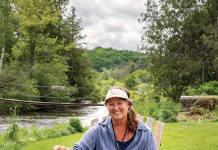Even after a lifetime of paddling, it still thrills me to make the first stroke with a paddle and feel the canoe leap forward and meet the pull of the current. There’s no better way to learn the secrets of a river. You can learn them in a kayak, as well, but I prefer canoes. I like the extra cargo capacity, and I appreciate sitting above the water rather than in it. Most of all, I like the tradition.
 There’s a hidden stretch of river not far from my home that offers decent fishing in every season. You can hike to it if you don’t mind busting through a couple miles of cedar and alder thickets. I did it once, in March, when I figured the swamp would be frozen and easy to walk across. It wasn’t. My snowshoes kept getting tangled in the tag alders, so I took them off and strapped them to my backpack, which already bulged with waders, fishing gear and lunch. After a few hours of plunging through ice and sinking into mud to my knees, I came to the river, but it was too high with meltwater to wade. I turned around, slogged back through the swamp, drove home and went to bed.
There’s a hidden stretch of river not far from my home that offers decent fishing in every season. You can hike to it if you don’t mind busting through a couple miles of cedar and alder thickets. I did it once, in March, when I figured the swamp would be frozen and easy to walk across. It wasn’t. My snowshoes kept getting tangled in the tag alders, so I took them off and strapped them to my backpack, which already bulged with waders, fishing gear and lunch. After a few hours of plunging through ice and sinking into mud to my knees, I came to the river, but it was too high with meltwater to wade. I turned around, slogged back through the swamp, drove home and went to bed.
In my canoe, I can reach that same stretch of river in 30 minutes. And more often than not, even on summer weekends, I can have it to myself.
When you paddle a canoe, you become part of the history of the Great Lakes region. For thousands of years, native boat builders refined their bark and wood canoes to meet the requirements of northern rivers and lakes. Some of those boats were large — as long as 36 feet — and could carry a ton or more of cargo and passengers on the Great Lakes. Others were sleek and fast and could transport a war party a hundred miles in a day. Others were small and nimble, for maneuvering in fast rivers. Today’s canoes are made from synthetic materials or aluminum, but their shape, their lines and their proportions virtually are unchanged from the bark canoes of the Ojibway.
Modern canoes also remain a perfect fit for our waters. We’re lucky, first of all, Michigan law dictates any stream large enough to float a log belongs to every citizen. In a canoe or kayak, you still can travel untaxed and unregistered, as free as anyone can be in this world of impediments and encumbrances.
 We’re lucky also to have so many waters to choose from. I’ve explored rivers across much of the U.S. and Canada and on two other continents, as well, but Michigan’s will always be my favorites. And not only the sand-and-gravel streams of the northern Lower Peninsula, where I grew up. I’m fascinated with the variety of rivers everywhere on both peninsulas.
We’re lucky also to have so many waters to choose from. I’ve explored rivers across much of the U.S. and Canada and on two other continents, as well, but Michigan’s will always be my favorites. And not only the sand-and-gravel streams of the northern Lower Peninsula, where I grew up. I’m fascinated with the variety of rivers everywhere on both peninsulas.
We have wide rivers and skinny ones, rivers that flow a few miles between lakes and others you can follow for a couple hundred miles, camping as you go. There are slow-running rivers stained dark with tannins; gravel-bottomed riffle-and-pool streams as clear as spring water; and furious whitewater rivers as challenging as any between the Rockies and the Appalachians. Some flow through the wildest forests in the state and others through the hearts of our cities. They meander through agricultural lands; through lowland forests and upland forests; down rock-strewn canyons. We have rivers to match every level of paddling experience. And each of them will take you to places you might otherwise never see.
Paddling a canoe is one of the best ways I’ve found to escape ordinary life. It’s such an effective antidote to obligations and responsibilities — and to the tyrannies of superhighways, airports and the internet — that I think of it as a form of social protest. There’s something timeless about it. It can make you forget time altogether.
Jerry Dennis’s book, “Canoeing Michigan Rivers: A Comprehensive Guide to 45 Rivers,” has long been considered the bible of paddling in Michigan. He has written about canoeing also in his books “From a Wooden Canoe,” “A Place on the Water” and “The Living Great Lakes.”







Facebook Comments